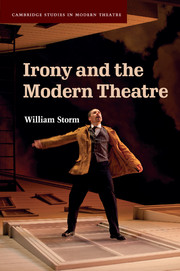Book contents
- Frontmatter
- Contents
- Acknowledgements
- Introduction
- 1 Irony personified: Ibsen and The Master Builder
- 2 The character of irony in Chekhov
- 3 Irony and dialectic: Shaw's Candida
- 4 Pirandello's “Father” – and Brecht's “Mother”
- 5 Absurdist irony: Ionesco's “anti-play”
- 6 “Ironist First Class”: Stoppard's Arcadia
- 7 American ironies: Wasserstein and Kushner
- 8 Irony's theatre
- Notes
- Works cited
- Index
1 - Irony personified: Ibsen and The Master Builder
Published online by Cambridge University Press: 01 June 2011
- Frontmatter
- Contents
- Acknowledgements
- Introduction
- 1 Irony personified: Ibsen and The Master Builder
- 2 The character of irony in Chekhov
- 3 Irony and dialectic: Shaw's Candida
- 4 Pirandello's “Father” – and Brecht's “Mother”
- 5 Absurdist irony: Ionesco's “anti-play”
- 6 “Ironist First Class”: Stoppard's Arcadia
- 7 American ironies: Wasserstein and Kushner
- 8 Irony's theatre
- Notes
- Works cited
- Index
Summary
Henrik Ibsen is masterful in his translation of an ironic world-view into the traits and behaviors of his characters, their interrelations, and the organizing structure of his dramatic action. In Hedda Gabler, when the title character marries George Tesman and not Eilert Loevborg, becomes vulnerable to the manipulations of Judge Brack and shoots herself with her father's pistols, she is enacting, among other behaviors, an inclusive ironic pattern. When Nora Helmer, in A Doll House, performs an elaborate show of domestic dutifulness, all the while sneaking macaroons and engaging in other, more helpful duplicities, she too is embodying the very ironic pattern that brings about the ultimate, and indeed logical, reversal – shutting the door on all that was apparently affirmed on her part in favor of another, more personal duty. And when, in The Master Builder, Halvard Solness refers with ironic self-awareness to his “luck,” he is intensely aware that the fabric of his life has been transformed – and continues to be fashioned – by a power of fortune that is not only double-edged but contradictory, bringing with it both blessing and catastrophe. Such “luck” is for Solness a manifestation not so much of providential good or ill but of an overarching pattern in its visitation upon individual fate. Luck of this signifying variety is also, of course, related by its very nature to the ironic.
- Type
- Chapter
- Information
- Irony and the Modern Theatre , pp. 13 - 37Publisher: Cambridge University PressPrint publication year: 2011



